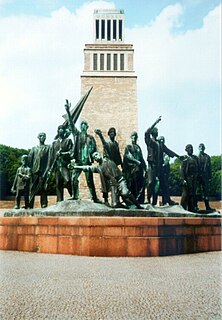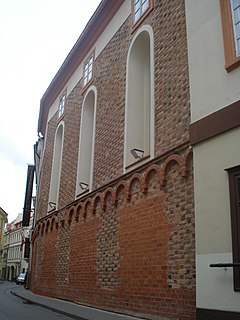
The Jedwabne pogrom was a massacre of Polish Jews in the town of Jedwabne, German-occupied Poland, on 10 July 1941, during World War II and the early stages of the Holocaust. At least 340 men, women and children were murdered, some 300 of whom were locked in a barn and burned alive. About 40 ethnic Poles carried out the killing; their ringleaders decided on it beforehand with Germany's Gestapo, SS security police or SS intelligence and they then cooperated with German military police. According to historian Jan T. Gross, "the undisputed bosses of life and death in Jedwabne were the Germans," who were "the only ones who could decide the fate of the Jews."
Marek Jan Chodakiewicz is a Polish-American historian specializing in Central European history of the 19th and 20th centuries. He teaches at the Patrick Henry College and at the Institute of World Politics. He has been described as conservative and nationalistic, and his attitude towards minorities has been widely criticized.
Żydokomuna is an anti-communist and antisemitic canard, or a pejorative stereotype, suggesting that most Jews collaborated with the Soviet Union in importing communism into Poland, or that there was an exclusively Jewish conspiracy to do so. A Polish language term for "Jewish Bolshevism", or more literally "Jewish communism", Żydokomuna is related to the "Jewish world conspiracy" myth.

Fritz Cremer was a German sculptor.

The Crveni Krst concentration camp, also known as the Niš concentration camp, located in Crveni Krst, Niš, was operated by the German Gestapo and used to hold captured Serbs, Jews and Romanis during the Second World War. Established in mid-1941, it was used to detain as many as 35,000 people during the war and was liberated by the Yugoslav Partisans in 1944. More than 10,000 people are thought to have been killed at the camp. After the war, a memorial to the victims of the camp was erected on Mount Bubanj, where many inmates were shot. A memorial museum was opened on the former campgrounds in 1967 and in 1979 the campgrounds were declared a Cultural Monument of Exceptional Importance and came under the protection of the Socialist Republic of Serbia.

Kaniūkai is a village in the Šalčininkai district municipality of Lithuania. According to the 2011 census, its population was 125.
Joanna Beata Michlic is a Polish social and cultural historian specializing in Polish-Jewish history and the Holocaust in Poland. An honorary senior research associate at the Centre for Collective Violence, Holocaust and Genocide Studies at University College London (UCL), she focuses in particular on the collective memory of traumatic events, particularly as it relates to gender and childhood.
The anti-Jewish violence in Central and Eastern Europe following the retreat of Nazi German occupational forces and the arrival of the Soviet Red Army – during the latter stages of World War II – was linked in part to postwar anarchy and economic chaos exacerbated by the Stalinist policies imposed across the territories of expanded Soviet republics and new satellite countries. The anti-semitic attacks had become frequent in Soviet towns ravaged by war; at the marketplaces, in depleted stores, in schools, and even at state enterprises. Protest letters were sent to Moscow from numerous Russian, Ukrainian and Belarusian towns by the Jewish Anti-Fascist Committee involved in documenting the Holocaust.

The Holocaust in Belarus is the term that refers to the systematic discrimination and extermination of Jews living in the former Byelorussian Soviet Socialist Republic which was occupied by Nazi Germany after August 1941 during World War II. It is estimated that roughly 800,000 Byelorussian Jews were murdered during the Holocaust. However, other estimates put the number of Jews killed between 500,000 and 550,000. Within the borders of modern Belarus, the death toll is estimated to be around 225,000

The Belarusian Auxiliary Police was a collaborationist paramilitary force established in July 1941. Staffed by local inhabitants from German-occupied Belarus, it had similar functions to those of the German Ordnungspolizei in other occupied territories.

Vasil Zacharka was a Belarusian statesman and the second president of the Belarusian People's Republic in exile.

The Genocide and Resistance Research Centre of Lithuania is a state-funded research institute in Lithuania dedicated to "the study of genocide, crimes against humanity, and war crimes in Lithuania; the study of the persecution of local residents by occupying regimes; the study of armed and unarmed resistance to occupying regimes; the initiation of the legal evaluation of the activities of the organisers and implementers of genocide; and the commemoration of freedom fighters and genocide victims." The centre was founded on 25 October 1992 by the Supreme Council of the Lithuanian Republic as the "State Genocide Research Centre of Lithuania". It is a member organisation of the Platform of European Memory and Conscience.

John-Paul Himka is an American-Canadian historian and retired professor of history of the University of Alberta in Edmonton. Himka received his BA in Byzantine-Slavonic Studies and Ph.D. in History from the University of Michigan in 1971 and 1977 respectively. The title of his Ph.D. dissertation was Polish and Ukrainian Socialism: Austria, 1867–1890. As a historian Himka was a Marxist in the 1970s–80s, but became influenced by postmodernism in the 1990s. In 2012 he defined his methodology in history as "eclectic".

Ivan Kamenec is a Slovak historian.

Jewish Motifs International Film Festival is a major Jewish-themed film festival held annually in Warsaw, Poland. The festival has been held every year since 2004.
Milan Stanislav Ďurica is a Slovak historian and theologian.
Yevhen Nakonechny was a Ukrainian historian, librarian, library scientist, linguist, and a teenage prisoner of the Soviet Gulag forced labour camp system during postwar Stalinist period for his involvement with the Organization of Ukrainian Nationalists (OUN).

Đakovo was an internment camp for Jewish, and to a lesser extent Serb, women and children in the town of Đakovo in the Independent State of Croatia (NDH) that was operational between December 1941 and July 1942, during World War II.
The historiography of the Holocaust in Slovakia has been a much-debated subject, and historians have still not arrived at a consensus position as to the role of the Slovak State in the Holocaust.

Jüri Lina is an Estonian journalist, writer, paranormal investigator, music producer, radio host, film director and Ufologist.













